Tavo Hellmund spoke recently at the TEDxAustin Conference emphasizing the impact the completed F1 Facilities will have on the local community by pursuing an approach of long term sustainability of the region. This will be accomplished through the implementation of not only the race track, but also the year round calendar of events which will include an emphasis on education.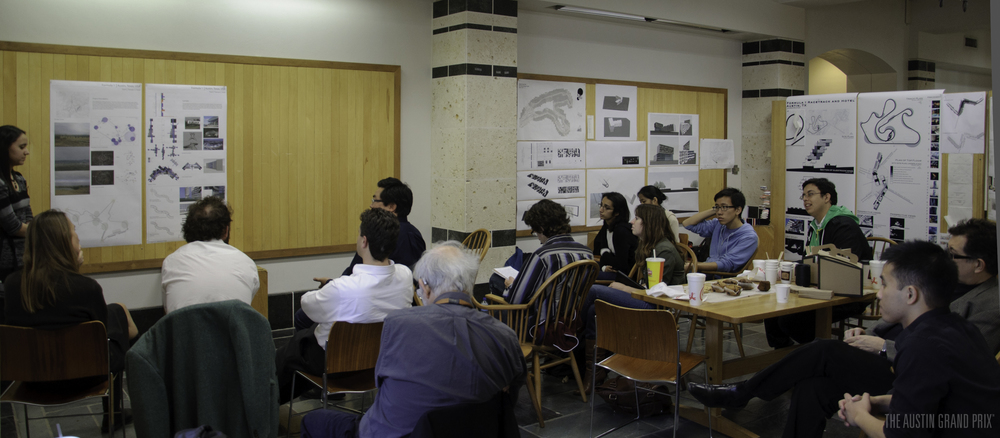 UT Architecture Students observe collegue during her review Though Tavo and most Austinites might not know it yet, the impact on the educational community has already been positively effected even though the facilities aren't even built yet. A design studio consisting of undergraduate students from the University of Texas at Austin School of Architecture recently explored the potential for track designs and hotel facilities at the track site.
UT Architecture Students observe collegue during her review Though Tavo and most Austinites might not know it yet, the impact on the educational community has already been positively effected even though the facilities aren't even built yet. A design studio consisting of undergraduate students from the University of Texas at Austin School of Architecture recently explored the potential for track designs and hotel facilities at the track site.
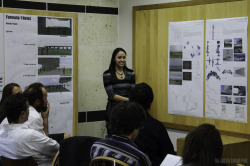 UT Architecture Student Valerie Lyall explains her track design concept to a guest review panel
UT Architecture Student Valerie Lyall explains her track design concept to a guest review panel
As some of you may know, I am a graduate student in the Masters of Architecture program and spend every waking moment in studio when I am not working hard to bring you the latest on The Austin Grand Prix. Though I was finished with my studio I was listening in on other reviews and stumbled upon theirs and snapped some pictures. Though I didn't get a chance to really get involved in the discussion, I set out to get connected with the students and professor about their work.
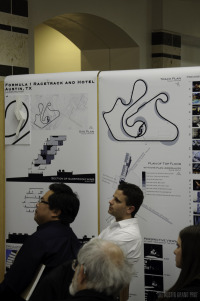 Guest Reviewers included Professor Uli Dangel (right), who worked on the TAG McLaren Headuarters in Woking, England while with Foster+Partners
Guest Reviewers included Professor Uli Dangel (right), who worked on the TAG McLaren Headuarters in Woking, England while with Foster+Partners
The studio project was coordinated by Larry Doll, Associate Professor at UT Architecture, and was a 5 week intensive design studio about developing a code within existing tracks from the 2010 season to help formulate a new potential design for the Austin facilities. The students then completed their project by proposing a new hotel to be located on the area and chose where and how to integrate it into the complex nature of a their track designs.
Students Brittany Milas and Kim Villavicencio (that's right boys, the girls love this F1 stuff too) where kind enough to offer their designs to us to share with our audience in a hope to raise awareness of the kinds of values and discussions that go into designing a F1 facility. Brittany worked with the Turkey Grand Prix and Kim with Brazilian Grand Prix track as their initial research into how the variation in track characteristics determines the unique conditions for the drivers and the fans.
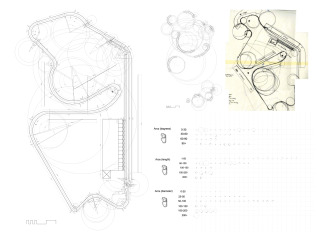 Kim Villavicencio explores G-Forces as the design code for a new track in AustinEach student's work focused on their new "code" derived from their studies of factors such as elevation changes, g-forces, radii of turns and others. The solutions proposed by the students began to quantify why the Belgian Grand Prix (SPA) elevation change is so critical, or how the Brazilian Grand Prix (Interlagos) simplistic plan achieves difficult handling conditions because of its compound curves. The solutions were all amazing in their own right, attempting to quantify the specific character that makes each track so special and what it means to create the new American F1 identity through the track design.
Kim Villavicencio explores G-Forces as the design code for a new track in AustinEach student's work focused on their new "code" derived from their studies of factors such as elevation changes, g-forces, radii of turns and others. The solutions proposed by the students began to quantify why the Belgian Grand Prix (SPA) elevation change is so critical, or how the Brazilian Grand Prix (Interlagos) simplistic plan achieves difficult handling conditions because of its compound curves. The solutions were all amazing in their own right, attempting to quantify the specific character that makes each track so special and what it means to create the new American F1 identity through the track design.
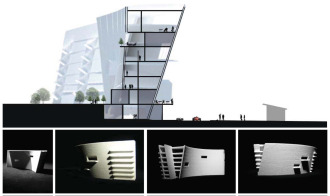 Brittany Milas designs a cantilevered hotel over her track design
Brittany Milas designs a cantilevered hotel over her track design
All of the questions raised by these talented and ambitious young designers exemplifies the amazing technical complexities of this amazing sport. Through just a five week program, they raised new questions about the concept of track design and may well have discovered a new way to create a new facility around the world.
Though modest in scale, this project signifies that the F1 facilities has already and will continue to positively impact the lives of countless other young Americans as they look to Formula 1 as a source of inspiration for their dreams and future careers.
more images in the gallery
The Austin Grand Prixtm will continue to bring the latest news on the local influence felt by the new track development in features titled "Community Impact." Please respect the ideas and designs of the students as we have received their exclusive permission to highlight their work for this post.
